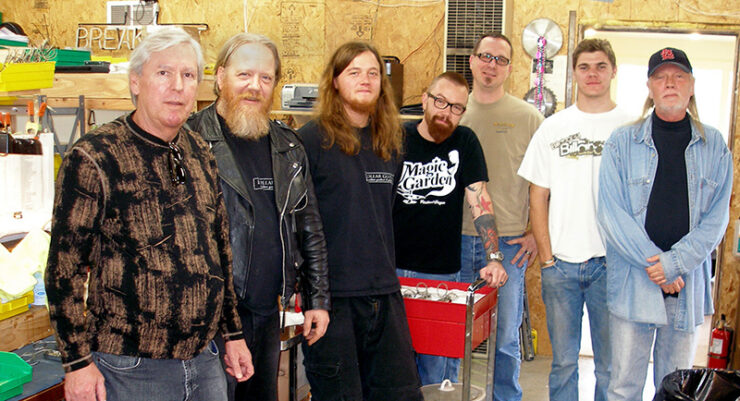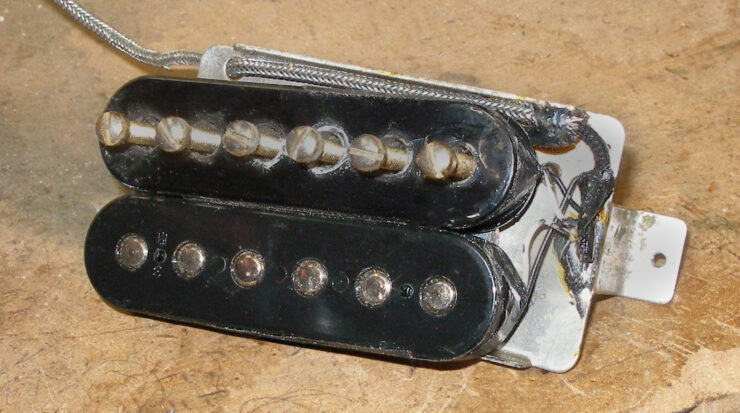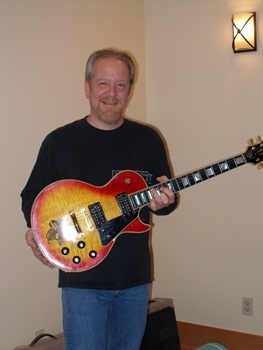
By Mike Wohl
You would be hard-pressed to find a more visceral, aggressive, or influential guitar sound than that of James Williamson’s 1969 Les Paul Custom on Iggy & The Stooges’ 1973 opus Raw Power. Described aptly by none other than Smiths luminary Johnny Marr, it’s a sound that is both “demonic and intellectual.” From slow burns like “Gimme Danger” to the switchblade ferocity of “Search and Destroy” and “Your Pretty Face is Going to Hell,” to the menacing closing track “Death Trip,” Williamson’s guitar is pushed to the front and buried in the red – virtuosic, yet unpretentiously explosive, and a perfect foil to Iggy Pop’s frenzied vocal delivery. It’s a sound that laid the groundwork for generations of heavy rock, punk, garage, and metal bands to follow, with countless players seeking to emulate Williamson’s abandon.
In the late 2000s, Jason Lollar was contacted by luthier Brian Michael of Gryphon Stringed Instruments in Palo Alto, CA on behalf of Williamson to help reverse engineer and reproduce the Gibson T-Top “patent number” humbuckers on the famous Raw Power Les Paul Custom, also known as the “Leopard Lady” guitar for its pinup-style artwork on the lower bout. Brian had previously worked with Jason on a custom pickup for a one-of-a-kind EBO-style bass for another legend, Mike Watt, who was holding down bass duties with the Stooges around that time. That collaboration, along with the Watt-Stooges connection, combined with Jason’s expertise and renown naturally lead to Michael reaching out.

Michael and Williamson had been working to build a replica of the famous guitar and wanted pickups that would be faithful to the original instrument. Williamson had taken a multi-decade hiatus from performing and was gearing up for a return to the stage. With the Leopard Lady living in the Rock n’ Roll Hall of Fame, Williamson sought tonal consistency in his various touring guitars, needing to be able to rely on them for the same wild, fiery tones that his Raw Power guitar conjured.
Jason recalls that “James first came to us for some specialized lap steel pickups just as he was coming out of a decades-long break of playing shows to join the Stooges after Ron Asheton passed. He brought the Raw Power Les Paul out to our shop on Vashon Island and left it with me for a couple weeks. James let me take the guitar apart and inspect anything I wanted to look at; I had the pickups completely removed and was able to get gauss readings, inductance, and even the resistance of each individual pickup. If you want to get close to recreating a particular pickup, these are some of the parameters you have to test — just getting an Ohm reading won’t help you much!”
Jason found some interesting details when reverse-engineering Williamson’s guitar: “Like a lot of vintage Gibson humbuckers the neck pickup had a higher resistance than the bridge — I have a 1971 LP Custom that is the same way. From seeing this so often, I believe they wound their pickups all the same, with no regard to distinct winding for neck or bridge. They would put them in bins and randomly pick and install them as the newly made guitars were outfitted with electronics. So, it’s not uncommon for the neck pickup to read higher.” It’s interesting to note that this is the inverse of how most contemporary builders make humbuckers, with a hotter pickup being more common in the bridge position to compensate for reduced amplitude of the string’s vibration closer to the bridge.

With the Leopard Lady in the shop, Jason came up with multiple prototypes that he was able to compare with the originals, eventually landing on the design that became the Lollar Raw Power humbucker. Williamson was immensely pleased with the result, saying that “Jason did an incredible job of replicating the pickups.” Since then, Williamson has used Lollar Raw Power humbuckers on a variety of instruments in his stable while on the road. The Raw Powers have become a popular product among both those looking for a more aggressive humbucker sound and fans of James’ guitar work.
For those chasing Williamson’s iconic Raw Power tone, he has mentioned that he used a Vox AC30 during recording, plugging his Les Paul Custom — without effects — straight into the Top Boost channel at full volume with the bass turned down. Much of the album’s playing was done with the bridge pickup. Williamson has remarked that the particularly lively sound of the Leopard Lady on Raw Power comes from a slightly lower output pickup through a bright amp at maximum volume. With this combination, the guitar itself remains more articulate and responsive rather than heavily compressed like it might be with a higher output pickup. Williamson has said that much of the bite or edge of his tone comes from the amp being pushed so hard. But of course, the most important aspect of the guitar sound on Raw Power is Williamson himself — somehow both reckless and deliberate, with a studied yet wild approach to guitar that continues to obliterate ears and minds.

Today, Lollar Pickups is proud to offer the Raw Power humbucker to guitarists like ourselves who have been inspired by James Williamson’s incredible and influential playing. Available with single or four conductor leads, and sold uncovered like the originals, Lollar Raw Power humbuckers can also be made to order with our various covers to suit player tastes. We’re honored to have been able to work with a player who has been such an enormous influence on so many of us around the shop. We’re humbled and grateful that James Williamson chose our pickups to outfit his guitars for a return to performing after such a long hiatus. “I remember when James came to see us, he said he had only recently started playing seriously again and that he had been working in computer technology for something like 30 years. Hard to imagine going back to work on an international tour at 2500 to 5000 capacity theaters!” recalls Jason, adding that seeing the Stooges around 2007 was “one of the best shows I’ve ever seen — and I’ve seen a lot!”
By Mike Wohl
